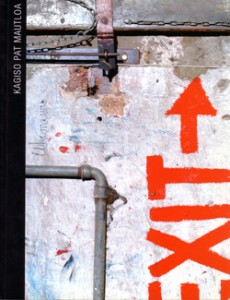Pat Mautloa is an essentially urban artist. Based in Johannesburg, he draws his inspiration from the street culture and dynamics of the changing city, and the images and people he encounters there. A graduate of the Rorke’s Drift Art and Craft Centre, he was involved in many local and international artists’ workshops in the 1980s and early 1990s, which helped a whole generation of black artists emerge onto the art scene despite the apartheid strictures imposed on them. He was a founder member of the Fordsburg Bag Factory, where his studio is still located. The book provides an overview of Mautloa’s work up to his most recent solo exhibition, as well as insight into his creative process and his central themes. Andries Walter Oliphant’s text includes discussions of Mautloa’s installation, assemblage, print and mixed media works, spanning his days as a student at Rorke’s Drift, and his active career of international Biennales and group exhibitions.
Andries Walter Oliphant is a poet, fiction writer, critic and cultural policy planner. Professor in Theory of Literature at the University of South Africa, his writings on South African literature, art and photography are widely published locally and internationally. He won the Thomas Pringle Award for Short Stories in 1991 and the Book Journalist of the Year Award in 1998. He is also the chair of the Arts and Culture Trust and the Network of Arts and Culture South Africa.
Philippa Hobbs is the author for the educational supplement published with TAXI-009 Kagiso Pat Mautloa.
EXTRACT FROM THE BOOK
FRAGMENTS OF AN URBAN MAP
Should you wish to meet Kagiso Patrick Mautloa, you could follow the route he takes to his studio every morning. The changing seasons spanned between the extremes of dry winters and summers of torrential rains would take you through a city which seems to change from hour to hour. Departing from Alexandra, where he lives, you would stroll through the shapeless township where broken tar-strips, revealing the textures of sand, take you past rusted metal and board structures, tightly packed together. You would see new housing developments below Reconstruction and Development billboards, and huge adverts for beer, mobile phone services and washing powder looming in the gloom – flaking and peeling. The area would be shrouded in smoke, the air sulphurous with anthracite. Alexandra township, a free-holding area from which black South Africans could not be removed under apartheid, would have an unreal, spectral quality. If it were winter, the homeless would be standing around braziers warming themselves. You would travel with other commuters: clerks, cleaners, builders, students, new arrivals to the city and the unemployed. From the north-east you would move in a south-westerly direction along a spine of store fronts. The road would rise and fall through Hillbrow, past Joubert Park and the Johannesburg Art Gallery on the eastern border of the city centre. You would show a keen but detached interest in your fellow travellers. Your observing eye would be unobtrusive but it would take in everything. The expressions on their faces would stay with you; their conversations, now coded, now abrasive, would strike you. The great variety in their dress would tell you something about their social stations. You would feel at ease, secure in your sense of self, but also a part of this dynamic community of urban dwellers in transit.
At the congested taxi rank in Noord Street, where the squares and rectangles of high-rise buildings dominate the sky, you would disembark. From there you would begin walking again. You would wind your way down along the sloping topography of the inner city streets towards the western end. You would see commuters stream down to, and emerge from, the platforms of the station below the street. You would pass clothing and furniture stores, jostle with crowds as you pass fruit, vegetable, shoe and food vendors. In the morning and late at night, the aroma and colour of fire filling your senses, you would stop to warm your hands, to chat or to buy a snack as you make your way down to Newtown. There you would go through the metal garage doors of the Bag Factory, the home of the Fordsburg Artistsà Studios, where you would find Mautloa in his studio cluttered with objects. This space is part of the city whose shapes and dimensions form the matrix from which he has forged his aesthetics. His artworks and materials, scattered and piled high in his studio, are fragments of an urban map. Although he was not born in the city, he spent most of his life in Johannesburg. He is an urban being and this is reflected in his work.
DETAILS OF BOOK
Full colour, Soft cover, 96 Pages, 10.7 x 8.3inches
Authors: Andries Oliphant
Editor: Bettina Schultz
Design and layout: Carina Comrie and Adele Prins
Publisher: David Krut Publishing
French Translator: Catherine Lauga du Plessis
Dutch Translator: Loes Nas
Printing: Keyprint
Paper: Millenium Matt 137 gsm
ISBN 0-9584496-7-8
© The authors, the artist, and David Krut Publishing, 2003
ENQUIRIES
TAXI-009: Pat Mautloa, available through David Krut Publishing

